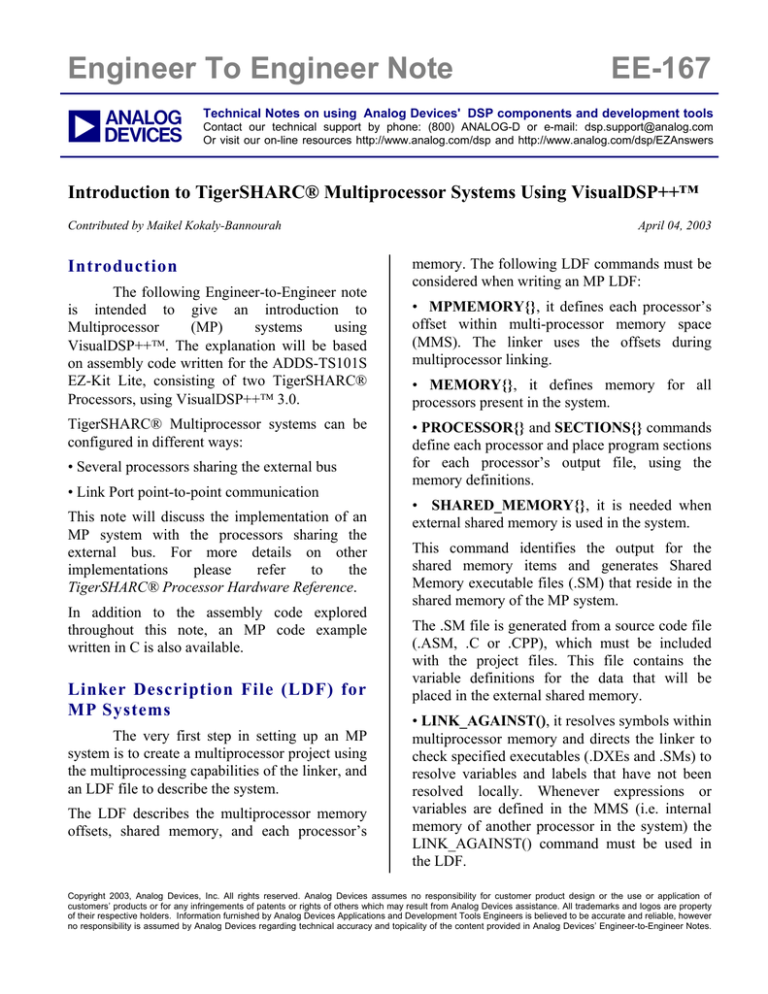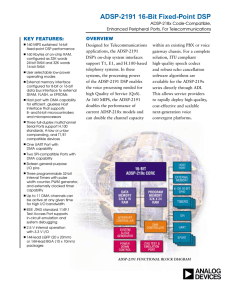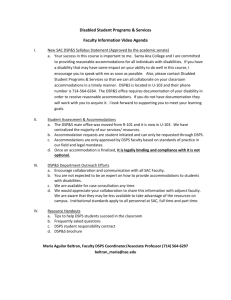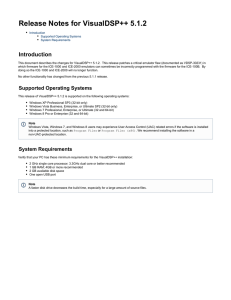a Engineer To Engineer Note EE-167
advertisement

Engineer To Engineer Note
a
EE-167
Technical Notes on using Analog Devices' DSP components and development tools
Contact our technical support by phone: (800) ANALOG-D or e-mail: dsp.support@analog.com
Or visit our on-line resources http://www.analog.com/dsp and http://www.analog.com/dsp/EZAnswers
Introduction to TigerSHARC® Multiprocessor Systems Using VisualDSP++™
Contributed by Maikel Kokaly-Bannourah
Introduction
The following Engineer-to-Engineer note
is intended to give an introduction to
Multiprocessor
(MP)
systems
using
VisualDSP++. The explanation will be based
on assembly code written for the ADDS-TS101S
EZ-Kit Lite, consisting of two TigerSHARC®
Processors, using VisualDSP++ 3.0.
TigerSHARC® Multiprocessor systems can be
configured in different ways:
• Several processors sharing the external bus
• Link Port point-to-point communication
This note will discuss the implementation of an
MP system with the processors sharing the
external bus. For more details on other
implementations
please
refer
to
the
TigerSHARC® Processor Hardware Reference.
In addition to the assembly code explored
throughout this note, an MP code example
written in C is also available.
Linker Description File (LDF) for
MP Systems
The very first step in setting up an MP
system is to create a multiprocessor project using
the multiprocessing capabilities of the linker, and
an LDF file to describe the system.
The LDF describes the multiprocessor memory
offsets, shared memory, and each processor’s
April 04, 2003
memory. The following LDF commands must be
considered when writing an MP LDF:
• MPMEMORY{}, it defines each processor’s
offset within multi-processor memory space
(MMS). The linker uses the offsets during
multiprocessor linking.
• MEMORY{}, it defines memory for all
processors present in the system.
• PROCESSOR{} and SECTIONS{} commands
define each processor and place program sections
for each processor’s output file, using the
memory definitions.
• SHARED_MEMORY{}, it is needed when
external shared memory is used in the system.
This command identifies the output for the
shared memory items and generates Shared
Memory executable files (.SM) that reside in the
shared memory of the MP system.
The .SM file is generated from a source code file
(.ASM, .C or .CPP), which must be included
with the project files. This file contains the
variable definitions for the data that will be
placed in the external shared memory.
• LINK_AGAINST(), it resolves symbols within
multiprocessor memory and directs the linker to
check specified executables (.DXEs and .SMs) to
resolve variables and labels that have not been
resolved locally. Whenever expressions or
variables are defined in the MMS (i.e. internal
memory of another processor in the system) the
LINK_AGAINST() command must be used in
the LDF.
Copyright 2003, Analog Devices, Inc. All rights reserved. Analog Devices assumes no responsibility for customer product design or the use or application of
customers’ products or for any infringements of patents or rights of others which may result from Analog Devices assistance. All trademarks and logos are property
of their respective holders. Information furnished by Analog Devices Applications and Development Tools Engineers is believed to be accurate and reliable, however
no responsibility is assumed by Analog Devices regarding technical accuracy and topicality of the content provided in Analog Devices’ Engineer-to-Engineer Notes.
a
Note: if .SM files and DXE files are included in
the command line, the .SM file must be placed
first, followed by all other DXE’s, for the linker
to be able to resolve the variables correctly.
a combination of different DSPs with different
architectures (i.e. ADSP-TS101S and ADSP21160) in the same LDF is not supported by
VisualDSP++.
The maximum number of processors that can be
declared in one LDF is architecture-specific (i.e.
maximum of 8 ADSP-TS101S’s). Also note that
Figure 1Excerpt from and MP LDF example
An MP LDF example where all the above
commands are used is shown in Figure 1. The
remaining of the LDF file is basically the same
as the default one provided with the tools
(please refer to the “Linker and Utilities
Manual for TigerSHARC® DSPs” or to “EE-69
Understanding and Using Linker Description
Files (LDFs)” for a general description on LDF
files).
In Figure 1, a 2 ADSP-TS101S and external
shared memory system is defined
Now that the different sections of the LDF have
been discussed, we can examine the example
code that explores some of the MP capabilities
of the processor.
For MP system hardware configuration please
refer to Cluster Bus chapter of the
TigerSHARC® Processor Hardware Reference.
Introduction to TigerSHARC® Multiprocessor Systems Using VisualDSP++™ (EE-167)
Page 2 of 12
a
Multiprocessor
(MMS)
Memory
Space
The multiprocessor memory space is
divided into a number of address regions (this
number is processor specific) that correspond to
the internal memory of the processors in an MP
system. The ADSP-TS101S’s multiprocessor
memory space appears in Figure 2.
not be used or other than in special cases where
data must pass through the TigerSHARC® bus
interface. Performing a self-multiprocessor
read access will set the SELF MPROC READ
bit in the SYSTAT register as an error
indication for the illegal access.
Example 1 shows source code where the MMS
is used to access a memory location of another
DSP in the system. In this case DSP with ID0
accesses a memory location in ID1’s internal
memory.
Example 1:
// Code in ID0
r0=0x02480000; //M0 Data in int mem of ID1
In example 1, the MMS address for ID1 is
0x2400000, which is then added to the address
corresponding to ID1’s internal memory
(0x80000). Therefore, this will result in a read
access of ID0 from ID1’s internal memory.
Figure 2 ADSP-TS101S’s Multiprocessor Memory
Space.
Depending on the address range used, the
internal memory of a particular DSP in the
multiprocessor system will be accessed as a
source or destination. Writes to the Broadcast
region access the memory of all DSPs in the
multiprocessing system.
For instance, accessing a memory location
within the address range 0x3000000 –
0x33FFFFF, is equivalent to accessing the
internal memory of the DSP in the MP system
with ID 4.
Note: A TigerSHARC’s® own Internal space
can be accessed via the multiprocessing space
for write transactions only. This, however, is
performed through the external bus and should
Note: In DSP multiprocessor systems including
SDRAM a DSP with ID=000 must be present,
since this DSP performs the initialization (MRS)
of the SDRAM. Also, there are issues related to
open drain pull-ups only enabled on the DSP
with ID=000. After reset, ID0 becomes the bus
master and priority rotates in a round robin
fashion, going up from the present master.
External Memory
The ADSP-TS101S has 6Mbits of onchip SRAM memory that can store both
program and data. However, some applications
also require the use of external memory devices.
External memory is widely used in MP systems,
and can be implemented as a shared resource for
all DSPs in the system, or dedicated to a
particular processor.
It is very important to keep in mind that all
DSPs in the system must set up the proper
access mode for the type of memory used in the
hardware system. The access mode is
Introduction to TigerSHARC® Multiprocessor Systems Using VisualDSP++™ (EE-167)
Page 3 of 12
a
programmed via the System Control (SYSCON)
register. Default power up/reset settings for
SYSCON are detailed in the TigerSHARC®
Processor Hardware Reference. User defined
settings must support the access mode
appropriate to the memory device(s) that the
user intends to use in their hardware systems.
SYSCON settings must be the same across all
devices sharing the cluster bus connection.
Note that SDRAM is gluelessly supported by
the ADSP-TS101S. As with the SYSCON
register, the SDRAM Configuration (SDRCON)
register of all processors in the system must be
initialized to the same value. Once the DSP’s
internal memory controller has been configured,
the external memory can be accessed by the
DSP via the external bus.
In this project, SDRAM was used as an external
shared resource for the two DSPs in the system.
The code shown in example 2 corresponds to
the SDRCON register initialization, which, as
previously mentioned, must be done by all
DSPs sharing the same external memory (in this
case, ID0 and ID1).
Example 2:
// Excerpt from ID0 & ID1: SDRAM Init.
j11 = j31 + 0x00005913;;
SDRCON = j11;;
// Enable SDRAM: ENA=1,CAS=2CL,pipedepth=0,
page=512w,
ref.rate=1200,trp=2,tras=5,init=1
Shared.asm contains the variable definitions for
the data that will be placed in external memory.
Note: the DSP with the lowest ID number (and
therefore highest priority in the system) is
responsible for initializing the external data
defined in the .ASM shared memory file during
the booting-up sequence.
Vector Interrupt (VIRPT)
Vector Interrupts are used for interprocessor communication between a host and a
DSP or between DSPs.
This interrupt is a general-purpose interrupt for
another master’s use. The host (or master DSP)
can issue a vector interrupt to the slave DSP by
writing the address of an interrupt service
routine to the VIRPT register. When serviced,
this high priority interrupt causes the DSP to
branch to the service routine at that address.
Example 3:
// Extract from ID1: VIRPT Generation
j1 = MMS_ID0 + VIRPT_REG;;
xr0 = VIRPT_ISR_ID0 - MMS_ID0;;
[j1 += j31]= xr0;;
In example 3, ID1 triggers a vector interrupt in
ID0 by writing the address of the service routine
to be served in ID0 (labeled VIRPT_ISR_ID0)
to the VIRPT register in ID0 (0x2180730 =
0x180730 VIRPT address + 0x2000000 MMS
ID0).
Note: In case an external defined label is used
for the ISR address (like in this example, i.e.
VIRPT_ISR_ID0), the MMS offset value of the
DSP serving the interrupt (MMS_ID0) must be
subtracted for the DSP to vector to the address
of the ISR correctly.
This is just an example of how inter-processor
VIRPT interrupts can be used as flags or just to
indicate program execution completion in MP
systems.
Bus Lock and Semaphores
Semaphores are useful for synchronizing
tasks performed in an MP system. A semaphore
is a flag, set of data or memory location that can
be accessed by any of the DSPs present in the
system.
In critical tasks (i.e. should not be interrupted),
when attempting a read-modify-write operation
Introduction to TigerSHARC® Multiprocessor Systems Using VisualDSP++™ (EE-167)
Page 4 of 12
a
on a semaphore, the DSP must have bus
mastership for the duration of the operation.
This can be achieved by using the DSP’s bus
lock feature, which retains mastership of the bus
and
prevents
other
processors
from
simultaneously accessing the semaphore.
A read-modify-write operation is accomplished
with the following steps (example 4):
1. Request bus lock by setting the BUSLK bit in
the BUSLK register.
2. Wait for bus mastership to be acquired
(condition codes BM and NBM can be used).
3. Read the semaphore, and write to it.
Example 4 is an excerpt from ID0’s code
demonstrating the use of Bus Lock in
combination with a Broadcast write:
must be located at the same address of each
DSP. Once the DSP has become the bus master,
it performs a broadcast write to the specified
address on every DSP, including itself.
Lastly, the BUSLK bit must be cleared to free
the bus after the broadcast transfer has finished.
Multiprocessor Data Transfers
Throughout the code, several types of
external port (EP) data transfers have been
implemented:
1. Direct Memory Access (DMA) between ID0
and ID1,
2. DMA from ID0 and ID1 to external memory
(SDRAM),
3. Core transfer from ID1 to ID0,
Example 4:
4. Broadcast Write to all DSPs in the system.
// Excerpt ID0 code: BROADCAST write using
// Bus Lock
The TigerSHARC® includes 14 DMA channels,
four of which are dedicated to external memory
devices: channels 0, 1, 2, and 3.
j11 = j31 + 1;;
BUSLK = j11;;
// Lock the bus
BUS_MASTER: if NBM, jump BUS_MASTER;;
// Check for bus mastership
DCS0 = xr3:0;;
yr0 = MMS_Broadcast;;
DCD0 = yr3:0;;
// Perform Broadcast data transfer
j11 = j31 + 0;;
BUSLK = j11;; // Relinquish the bus
While the BUSLK bit is set, the DSP can
determine if it has acquired bus mastership by
executing a conditional instruction with the Not
Bus Master (NBM) condition code. If it has
become the bus master, the DSP can proceed
with the external read or write. If not, it can
either clear its BUSLK bit and try again later, or
simply wait until the bus is acquired.
Bus lock can be used in combination with
broadcast writes to implement reflective
semaphores in a multiprocessing system. The
reflective semaphore (i.e. located in the DSP’s
internal memory or an I/O processor register)
For details on DMAs and how the different data
transfers are performed, please refer to “EE-143
Understanding DMA on the ADSP-TS101S
TigerSHARC®” and the DMA Controller
chapter of the TigerSHARC® Processor
Hardware Reference.
Let’s now examine the different types of data
transfers performed in this specific MP project.
Note that the Broadcast Write has already been
discussed in the previous sections.
DMA transfer from ID0 to ID1
This example shows a DMA transfer from
internal memory of ID0 to internal memory of
ID1. In this case, DMA channel 0 is used to
transmit the data stored in tx_ID0 to rx_ID1.
For this kind of transmission, two transfer
control blocks (TCBs), one for the source and
another one for the destination, must be set up.
Introduction to TigerSHARC® Multiprocessor Systems Using VisualDSP++™ (EE-167)
Page 5 of 12
a
Example 5 shows the loaded values into each
TCB using DMA channel 0. Note that the value
in register xr2/yr2 is irrelevant due to the fact
that 2-dimensional DMA is not selected for this
particular example. As soon as both the source
and destination TCBs are loaded with values the
DMA transfer starts.
Once the DMA is completed an interrupt occurs
and the _dma_ int vector interrupt routine is
then run.
DMA from ID1 to SDRAM
As in example 6, this is a DMA data transfer
from internal memory (in this case from ID1
instead of ID0) to the SDRAM.
Again, the same concepts apply, where the
source and destination TCBs are set up as
shown in example 7.
Example 7:
// Excerpt from ID1: DMA0
// External Port transfer from ID1 to SDRAM
Example 5:
// Excerpt from ID0: DMA0
// External Port transfer from ID0 to ID1
xr0 = tx_ID0;;
// xr0=index= ID0
xr1 = 0x00100004;; // count=0x10,modify=4
xr3 = 0x47000000;; // int mem,prio=norm,
//2D=no,word=quad,int=yes,RQ=enbl,chain=no
DCS0 = xr3:0;;
// Source
yr0 = rx_ID1;;
// xr0=index= ID1
yr1 = 0x00100004;; // count=0x10,modify=4
yr3 = 0x87000000;; // ext mem,prio=norm,
//2D=no,word=quad,int=yes,RQ=enbl,chain=no
DCD0 = yr3:0;;
// Destination
DMA transfer from ID0 to SDRAM
The transfer of the data from internal memory of
ID0 to the SDRAM is executed with minor
alterations to the previous example. The source
TCB is loaded with the same contents as before
(xR3:0) and the destination TCB is written with
the values of registers yr3:0 where yr0 is altered
from rx_ID1 to shared_data.
In this case, DMA channel 1 is used for the data
transfer by replacing DCS0 and DCD0 with
DCS1 and DCD1 respectively.
Example 6:
// Excerpt from ID0: DMA0
// Ext Port transfer from ID0 to SDRAM
DCS1 = xr3:0;;
// Same as before
yr0 = shared_data;; // xr0=index= SDRAM
DCD0 = yr3:0;;
// Destination
xr0 = tx_ID1;;
// xr0=index= ID1
xr1 = 0x00100004;; // count=0x10,modify=4
xr3 = 0x47000000;; // int mem,prio=norm,
//2D=no,word=quad,int=yes,RQ=enbl,chain=no
DCS0 = xr3:0;;
// Source
yr0 = shared_data+TAPS;; //xr0=index=SDRAM
yr1 = 0x00100004;;
//count=0x10,modify=4
yr3 = 0x87000000;;
//ext mem,prio=norm,
//2D=no,word=quad,int=yes,RQ=enbl,chain=no
DCD0 = yr3:0;;
// Destination
The source TCB is loaded with the same
contents as before (xR3:0) with the only
variation that the index now points to internal
memory of ID1, tx_ID1. The destination TCB is
written with the values of registers yr3:0 where
yr0 now points to shared_data+TAPS. TAPS is
the offset value used to point to the second half
of the buffer declared in SDRAM to prevent
from overwriting the already transferred data by
ID0. Once again, DMA channel 0 is used.
Core transfer from ID1 to ID0
Core transfer is a different way of handling data
where no DMA is used. In this case, the Integer
Arithmetic Logic Unit (IALU) is used to
directly transfer data from internal memory of
ID1 to internal memory of ID0.
An example of this is shown below:
Example 8:
Note: writing to an active TCB, i.e. back-toback DMA using the same channel before the
current transfer has completed, results in an
illegal operation. An error indication will be
flagged in the DMA status register (DSTAT).
// Excerpt from ID1: Core transfer
// from ID1 to ID0 using the IALU
jB0 = tx_ID1;; // Base address in ID1
j0 = jB0;;
// Set index equals to base
jL0 = TAPS;;
// Set buffer length
Introduction to TigerSHARC® Multiprocessor Systems Using VisualDSP++™ (EE-167)
Page 6 of 12
a
jB1 = rx_ID0;; // Base register in ID0
j1 = jB1;;
// Set index equals to base
jL1 = TAPS;;
// Set buffer length
j4 = 1;;
LC0 = TAPS;;
write_ext:
// Set loop modifier
// loop counter
xr0 = CB[j0 += j4];;
// read data from tx_ID1
CB[j1 += j4] = xr0;;
// write data to rx_ID0
if NLC0E, jump write_ext;;
// keep looping until completion
Two data arrays are declared, one in each DSP’s
internal memory. ID1 writes to the array stored
in ID0 through MMS (tx_ID1 to rx_ID0). The
IALU registers are used to access the two data
buffers to perform the direct data transfer.
Some Performance Considerations
Core data transfers are a nice and fast way of
transferring words of data since there is no need
to set up a transfer control block of any kind.
However, DMA is a better choice when large
amounts of data need to be transferred since the
core can be utilized for computational
processing. Remember that DMA transfers
operate in the background freeing up the core.
ID Checking
This routine can be used to check
whether the executable file generated gets
loaded into the correct DSP in the system. It
ensures no ID mismatch.
Example 9:
// Extract from ID1: ID Checking
xR0 = 0x3;;
// FEXT operand
xR1 = SYSTAT;;
// read SYSTAT
xr2 = 1;;
// DSP = ID1
xR1 = FEXT R1 by R0;; // get ID value
xr1 = r2 - r1;;
// is DSP ID1?
if NAEQ, jump incorrect_ID;;
// if false, stop and enter endless loop
Basically, it reads the DSP ID value from the
SYSTAT register and it compares it with the
theoretical value of the DSP ID. In this case, the
code has been written for ID1, so it makes sure
it has been loaded into the correct target that is
DSP 1. If false, it will enter an endless loop
indicating that an error has occurred.
Multiprocessor
Support
Debugger
VisualDSP++
Multiprocessor
Debugger provides the user with full system
evaluation using the Emulator. The Emulator
allows code testing and evaluation on the
hardware
platform.
I/O
inter-processor
communications as well as MMS data transfers
are supported. MP debugger operations like MP
load, run or reset provide the user with the
capability of testing the system with full
synchronization of all DSPs. Some of the MP
debugger features are:
• Multiprocessor debug commands allow the
user to download, reset, restart, run and step
through the code just like with single-processor
commands,
except
that
they
work
synchronously on all active DSPs in the selected
MP group.
• The Debugger provides a Multiprocessor
Status window. This window displays the
current status of each DSP in the system:
Running, Halted, or Unknown.
• The contents of each debugger window within
an MP emulation debugger session reflects the
selected DSP, i.e. the window in Focus.
• By default, the contents of each window will
change depending on which DSP is in focus.
The debugger supports Pinning windows
(Memory, Registers, etc.) dedicating them to a
specific DSP in the MP system. This will allow
the user to dedicate a particular debugger
window to only display information from one
particular DSP in the system, as opposed to
having the contents of the window change
whenever a new processor is selected via the
MP Status window.
•The debugger provides a Multiprocessor Group
window from which the processors can be
grouped into multiple, logical units upon which
Introduction to TigerSHARC® Multiprocessor Systems Using VisualDSP++™ (EE-167)
Page 7 of 12
a
all MP commands are applied. This window is
particularly useful when many processors are
present in a system and the user wishes to
control/debug subsets of these processors
together.
Use pinning, and the processor status items in
the Multiprocessor window, in conjunction with
single-processor debug commands to debug
individual processors in an MP session.
Figure 3 Multiprocessor Debugger Support
VisualDSP ICE Configurator
The Debugger allows the use of emulator
targets. The DSP In Circuit Emulator (ICE) is a
development tool for debugging programs
running in real time on DSP target system
hardware. The emulator reads executable files
and loads them into the DSP.
The ICE provides a controlled environment for
observing, debugging, and testing activities in a
target system by connecting directly to the
target processor through its JTAG interface.
For the MP system emulation, the SummitICE™ Universal Emulator system was used. As
a first step, the MP platform must be configured
using the VisualDSP ICE Configurator. The
Configurator is used to describe the user’s
hardware platform to the JTAG emulator. Once
a platform has been described, an emulator
target session can be based upon it. The
following steps should be followed when
configuring the MP platform:
1. Open the Visual DSP ICE Configurator.
2. Create a new platform.
3. Specify the name, number and type of devices
to be included as part of the platform.
These steps are illustrated in Figure 4.
Please be aware of the Initial Reset on Startup
option, which appears in the Device Properties
Introduction to TigerSHARC® Multiprocessor Systems Using VisualDSP++™ (EE-167)
Page 8 of 12
a
window shown in Figure 4. Enabling this
option will perform a complete reset on the
selected device every time the emulator session
is initiated. In systems where some settings may
need to be preserved (i.e. SDRCON register)
this option should be cleared.
Note: there is also a similar option in the
debugger itself, reset before loading executable,
which performs a complete reset of all devices
in the system upon downloading code to the
DSPs. This option can be found under
Settings/Target Options/.
Figure 4 VisualDSP ICE Configurator
ICE Test Utility and JTAG Scan Test
Before getting into the actual system debugging,
the ICE must be tested to make sure that has
been properly configured.
emulator I/O address, check the continuous scan
box and start testing. The scan test will then be
performed and the output window would look as
follows after a successfully completed scan test:
The ICE Test Utility (Figure 5) is used for this
purpose. Open the utility, select the proper
Introduction to TigerSHARC® Multiprocessor Systems Using VisualDSP++™ (EE-167)
Page 9 of 12
a
Similarly, the recommended
procedure is as follows:
Figure 5 VisualDSP ICE Test Utility
In case the test does not complete successfully,
an error message will be displayed with a
possible solution for the problem. Here is a
description of some issues that should be kept in
mind for the system design:
1. In a multiprocessor system it is imperative
that the JTAG header is buffered. This will keep
the signals clean and avoid noise problems that
occur with longer signal traces (ultimately
resulting in reliable emulator operation).
power-down
•
Close VisualDSP++ IDDE.
•
Disconnect POD from JTAG header of
target.
•
Power-down the target.
•
Replace jumpers on /TRST and TCK of the
JTAG header of target (for next power up).
Please refer to “EE- 68 Analog Devices JTAG
Emulation Technical Reference (2.5)” for a
more detailed description on this topic.
MP System Emulation
Now that the MP project has been created and
the emulator platform is ready for debugging,
we can begin with the hardware emulation.
2. In one scan chain, it is not recommended to
use more than eight physical devices (although,
theoretically, the devices that can be supported
in one JTAG scan chain by the software is about
50). The recommendation of not more than eight
physical devices is mostly due to the
transmission line effects that appear in long
signal traces, and based on some field-collected
empirical data.
3. The recommended power-up procedure for
the target and emulation system is as follows:
•
Power up PC with POD connected to the PC
but not the target.
•
Power up the target with jumpers on /TRST
and TCK of the JTAG header.
•
Remove jumpers on /TRST and TCK from
the JTAG header of target.
•
Connect POD to JTAG header of target.
•
Open VisualDSP++ IDDE.
Figure 6 Load Multiprocessor Processor Window
First of all, the DSP executable files (.DXE’s)
are downloaded to the corresponding DSPs. For
MP emulation, a Load Multiprocessor
Confirmation window (Figure 6) appears. This
window enables the user to select which .DXE
file is loaded into which DSP.
Once the code has been successfully loaded into
each DSP, the system can be fully evaluated
using the MP features previously described.
Introduction to TigerSHARC® Multiprocessor Systems Using VisualDSP++™ (EE-167)
Page 10 of 12
a
After running the code in both DSPs the user
can view the contents in the data memory
windows and should be able to verify that all
data transfers between the two DSPs have
completed successfully.
Figure 7 illustrates a classical example of some
of the MP debugger windows that can be
viewed when evaluating the system.
Running
code
in
the
DSP
targets
(synchronously in both DSPs or independently),
setting up break points, viewing the memory
contents, and system registers are just some of
VisualDSP++
Multiprocessor
debugger
capabilities.
Figure 7 VisualDSP++ Multiprocessor Session
Introduction to TigerSHARC® Multiprocessor Systems Using VisualDSP++™ (EE-167)
Page 11 of 12
a
References
[1] TigerSHARC®
Processor
Hardware
Reference, First Edition, March 2003.
Analog Devices Inc.
[2] VisualDSP++ Linker & Utilities Manual for
TigerSHARC® DSPs, Analog Devices Inc.
[4] Analog Devices JTAG Emulation Technical
Reference (2.5) (EE-68), Analog Devices
Inc.
[5] Understanding DMA on the ADSP-TS101S
TigerSHARC® (EE-143), Analog Devices
Inc.
[3] VisualDSP++ Emulation Tools Installation
Guide for Windows 95/98/NT/2000, Analog
Devices Inc.
Document History
Version
Description
April 04, 2003 by Maikel Kokaly-Bannourah
Updated trademark usage and upgraded code example according
to VisualDSP++ release 3.0
June 26, 2002 by Maikel Kokaly-Bannourah
Initial Release
Introduction to TigerSHARC® Multiprocessor Systems Using VisualDSP++™ (EE-167)
Page 12 of 12






